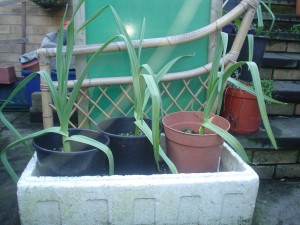Planted tomato seeds today
The seed trays are sitting on our windowsill, covered with a piece of metal grille to stop the cats from kicking them about. This year I’ve planted Gardener’s Delight, Brandywine and Tumbling Tom.
What I did with the fig tree last autumn
At the end of last October, I did a job I’d been meaning to do for a couple of years, but had never quite mustered up the courage for. The job in question was to prune our fig tree. It had been planted there by our landlords, who probably didn’t realise just how big this thing would eventually grow. Given that our garden is a tiny triangular courtyard with a few raised beds, a fig tree isn’t the first thing I would have thought of growing there. Nonetheless, the tree has flourished and every summer, provides us with a nice crop of gorgeous fruit (try a fig and goat’s cheese salad with olives, home grown tomatoes and rocket. Or chop the figs up and have them with porridge for breakfast).
I am a bit rubbish at pruning and I was worried that I’d end up killing the tree. As I write this, there are tiny leaf buds on the tree so my fears were unfounded. Going forward, the plan is now to prune the tree every year, according to the advice given by Bob Duncan in Fruit Trees and More:
In a temperate climate like Bob’s (and ours), there isn’t enough heat to ripen the main crop of figs (i.e. the crop that develops on any new shoot growth). Only the so-called breba crop, which starts to grow in spring on the previous year’s shoot growth, will actually ripen off properly. So every spring (late March/early April judging by when the video was posted), Bob prunes back any two year old branches, i.e. branches that produced figs the previous year. The one year old branches are left in place, because they’re the ones that will produce the figs this year. The advantage of this system is that your tree never grows any higher, because you’re always chopping back the two year old branches. So this year, our fig tree won’t have many fruit on it at all but as of next year, we shall start to reap the benefits in terms of crop and ease of harvest. Fingers crossed.
Anyway, the pictures below – taken a couple of weeks ago – show our pruned fig tree, with bonus helpful cat. The strange lump to the right of the compost bin is a pile of clothing, tea towels etc. which are quietly rotting down underneath their covering of nylon net curtain.
Elephant garlic redux
My last attempt at planting elephant garlic was in 2011. It wasn’t totally successful – I got a crop out of it, but the bulbs I ended up with were the same size as normal garlic. Put it this way, there was nothing “elephant” about them. This time round, I’ve used bigger pots – ten inches in diameter rather than 6 or 7. Hopefully this will do the trick. I planted the bulbs last October, and as you can see, they’re doing pretty well:
Top tip: I grew mizuna from seed in the same pots as the garlic. So while the garlic was sprouting last autumn, I also had a crop of salad leaves.
Categories: crops Tags: elephant garlic, garlic, mizuna
Things you can compost: jeans edition
The picture below was taken last autumn and shows a couple of containers of mizuna. (Actually, it’s not just mizuna in those containers, but that’s for another post.) The bluish-grey mess on the right is something that started life as a pair of jeans. They spent some months in our Dalek compost bin and this is the result – all the cotton has rotted down, leaving strands of polyester and Lycra behind. It’s quite annoying having to fish out strands of synthetic fibre from our compost so I’ve now created a separate pile outside the compost bin, which is reserved for mixed fibre items like jeans, T-shirts, sheets etc. that are too nasty/stained/ripped to be given to a charity shop. Once the worms have had their fill, the synthetic residue is put out for the bin men!



